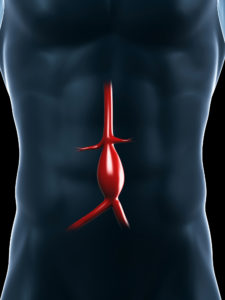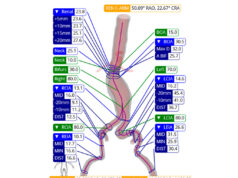 The United States Preventive Services Task Force (USPSTF) recently released an update to their 2014 abdominal aortic aneurysm (AAA) screening recommendations. The update is essentially a reiteration. They recommend a one-time screening with ultrasonography in asymptomatic men aged 65 to 75 years who have ever smoked (grade B) and selective screening in men aged 65 to 75 years who have never smoked (grade C). They also recommend against screening in asymptomatic women who have never smoked (grade D), and state there is insufficient evidence to determine the benefit of screening women aged 65 to 75 years who have ever smoked.1
The United States Preventive Services Task Force (USPSTF) recently released an update to their 2014 abdominal aortic aneurysm (AAA) screening recommendations. The update is essentially a reiteration. They recommend a one-time screening with ultrasonography in asymptomatic men aged 65 to 75 years who have ever smoked (grade B) and selective screening in men aged 65 to 75 years who have never smoked (grade C). They also recommend against screening in asymptomatic women who have never smoked (grade D), and state there is insufficient evidence to determine the benefit of screening women aged 65 to 75 years who have ever smoked.1
The recommendations are still based mainly on four large, population-based randomized controlled trials.2–5 These four trials have severe limitations that put their relevance to the U.S. population in question.
The studies predominately include Caucasian men 65 years and older, are from outside the United States and are approximately two decades old. With a mortality rate of over 80% for ruptured AAAs, researchers should strive to identify which Americans are most at risk.6
Now consider that 34–41% of AAA-related deaths are in women, 22% are in nonsmokers and 9% in men younger than 65 years. None of these groups are covered under the updated USPSTF guidelines.7–9 The Society for Vascular Surgery (SVS) 2017 guidelines partially addressed this gap by also recommending screening in women 65 to 75 years with a history of tobacco use and men and women older than 75 years in good health with a history of tobacco use.10
Pushing this further, the United Kingdom’s National Institute for Health and Care Excellence (NICE) draft guidelines recommend screening men and women with more than one risk factor including smoking, male sex, age greater than 65 years, hypertension, chronic obstructive pulmonary disease, atherosclerotic cardiovascular disease and family history of AAA.11
The NICE recommendations were made, in part, due to a study showing that AAA screening is cost-effective with a prevalence as low as 0.35–0.5%.12 The advent and advancement of endovascular aortic repairs (EVARs) have also increased the benefit of AAA screening. One study found select, healthy patients older than 75 years with AAA benefit from an EVAR and have an operative mortality of 1.4%.13
In a recent JAMA Surgery editorial, SVS member Marc Schermerhorn, MD, notes an important clinical impact of the USPSTF guideline—private insurers are only mandated to cover grade A and B recommendations under the Patient Protection and Affordable Care Act.14 This means only men aged 65 to 75 years who have ever smoked would be covered. Therefore patients not in that category, but who have several high-risk factors for AAA, would have to pay out-of-pocket for screening.
Since 2014, there have been many published studies concerning AAA prevalence, screening and treatment, but they have not been of adequate caliber for the USPSTF to justify expansion.1
There is still a paucity of data regarding the prevalence of AAA, especially in the U.S. Therefore, current risk prediction and efficacy models are anemic. In addition to evaluating the available evidence, the USPSTF assesses the benefit-to-risk ratio for screening exams. The risks of expanding the screening guidelines include increased number of operations and their inherent mortality, in addition to the economic burden that results. Research on psychological and quality of life harms from an AAA diagnosis have been conflicting and not clinically significant.3, 15–17
The USPSTF’s goal is to “[work] to improve the health of all Americans.” In this context, the aim is to save lives by preventing AAA ruptures and avoiding the associated mortality risk. Screening is the only practical method for achieving this objective. The USPSTF has identified key gaps in research that the community should diligently work to fill. In the meantime, physicians should still maintain a high index of suspicion in the following groups who may remain outside of the screening guidelines:
Males ages 45–65 with a significant history of tobacco use
Males ages 65–75 who have never smoked but have other risk factors
Females ages 65–75 who have ever smoked
Healthy males and females over the age of 75
References
1. Owens DK, Davidson KW, Krist AH, Barry MJ, Cabana M, et al. Screening for Abdominal Aortic Aneurysm: US Preventive Services Task Force Recommendation Statement. JAMA. 2019;322(22):2211–8.
2. Lindholt JS, Juul S, Fasting H, Henneberg EW. Screening for abdominal aortic aneurysms: single centre randomised controlled trial. BMJ. 2005;330(7494):750.
3. Ashton HA, Buxton MJ, Day NE, Kim LG, Marteau TM, Scott RA, et al. The Multicentre Aneurysm Screening Study (MASS) into the effect of abdominal aortic aneurysm screening on mortality in men: a randomised controlled trial. Lancet. 2002;360(9345):1531–9
4. Norman PE, Jamrozik K, Lawrence-Brown MM, Le MT, Spencer CA, Tuohy RJ, et al. Population based randomised controlled trial on impact of screening on mortality from abdominal aortic aneurysm. BMJ. 2004;329(7477):1259.
5. Scott RA, Wilson NM, Ashton HA, Kay DN. Influence of screening on the incidence of ruptured abdominal aortic aneurysm: 5-year results of a randomized controlled study. Br J Surg. 1995;82(8):1066–70.
6. Reimerink JJ, van der Laan MJ, Koelemay MJ, Balm R, Legemate DA. Systematic review and meta-analysis of population-based mortality from ruptured abdominal aortic aneurysm. Br J Surg. 2013;100(11):1405–13.
7. Egorova N, Giacovelli J, Greco G, Gelijns A, Kent CK, McKinsey JF. National outcomes for the treatment of ruptured abdominal aortic aneurysm: comparison of open versus endovascular repairs. J Vasc Surg. 2008;48(5):1092–100, 100 e1–2.
8. Kung HC, Hoyert DL, Xu J, Murphy SL. Deaths: final data for 2005. Natl Vital Stat Rep. 2008;56(10):1–120.
9. Longo C, Upchurch GR, Jr. Abdominal aortic aneurysm screening: recommendations and controversies. Vasc Endovascular Surg. 2005;39(3):213–9.
10. Chaikof EL, Dalman RL, Eskandari MK, Jackson BM, Lee WA, Mansour MA, et al. The Society for Vascular Surgery practice guidelines on the care of patients with an abdominal aortic aneurysm. J Vasc Surg. 2018;67(1):2–77 e2.
11. Excellence NIfHaC. Abdominal aortic aneurysm: diagnosis and management. online2018.
12. Glover MJ, Kim LG, Sweeting MJ, Thompson SG, Buxton MJ. Cost-effectiveness of the National Health Service Abdominal Aortic Aneurysm Screening Programme in England. Br J Surg. 2014;101(8):976–82.
13. O’Donnell TFX, Wade JE, Liang P, Li C, Swerdlow NJ, DeMartino RR, et al. Endovascular aneurysm repair in patients over 75 is associated with excellent 5-year survival, which suggests benefit from expanded screening into this cohort. J Vasc Surg. 2019;69(3):728–37.
14. Schermerhorn M. Updated US Preventive Services Task Force Recommendations for Abdominal Aortic Aneurysm—Are We Really Up To Date? JAMA Surg. 2019.
15. Spencer CA, Norman PE, Jamrozik K, Tuohy R, Lawrence-Brown M. Is screening for abdominal aortic aneurysm bad for your health and well-being? ANZ J Surg. 2004;74(12):1069–75.
16. Lucarotti ME, Heather BP, Shaw E, Poskitt KR. Psychological morbidity associated with abdominal aortic aneurysm screening. Eur J Vasc Endovasc Surg. 1997;14(6):499–501.
17. Lesjak M, Boreland F, Lyle D, Sidford J, Flecknoe-Brown S, Fletcher J. Screening for abdominal aortic aneurysm: does it affect men’s quality of life? Aust J Prim Health. 2012;18(4):284–8.
Kelli L. Summers is an integrated resident in vascular surgery at the Louisiana State University Health Sciences Center in New Orleans. Malachi Sheahan III is the Claude C. Craighead Jr. professor and chair in the division of vascular and endovascular surgery at the same institution. He is the medical editor of Vascular Specialist.












